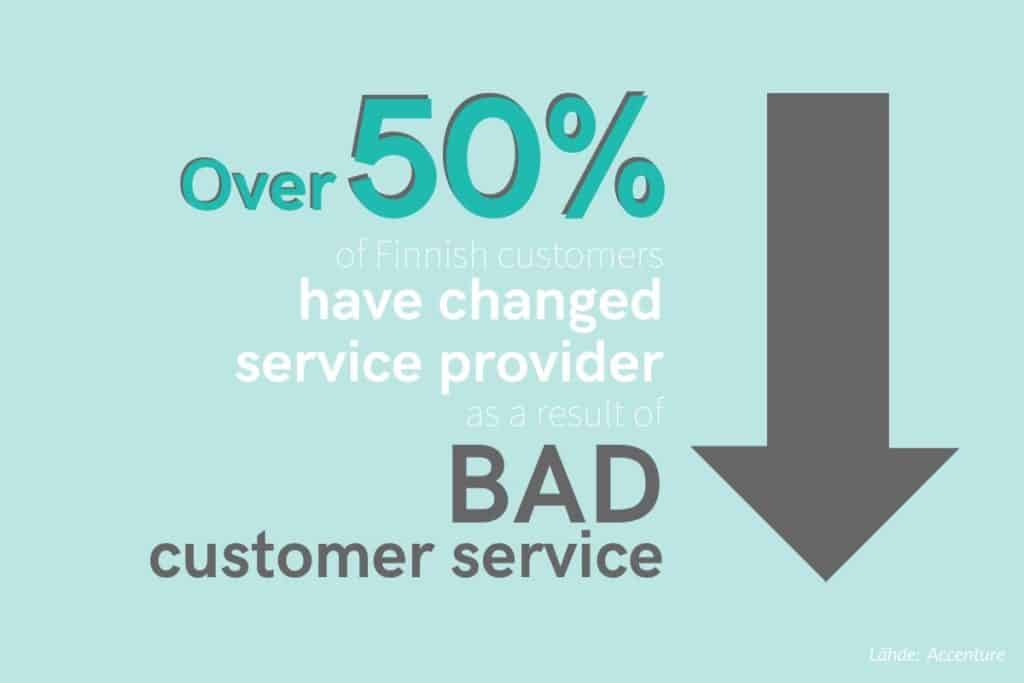Numerous studies highlight how significant customer experience is. One study shows that in the United States alone, companies lose 62 billion dollars due to poor customer experiences. According to Accenture’s Global Consumer Pulse Research, more than half of Finns have switched service providers because of poor service. Imagine, more than half


Customer experience has been a topic of discussion for a long time. Studies keep coming in, and they mostly paint a grim picture of the state of customer experiences. So, how can we improve customer experience?
I believe that customer service is and will always be the most important factor affecting a company’s customer experience and loyalty. Especially in contact centers, where tens of thousands, even hundreds of thousands, of interactions occur annually, poor customer experiences can be saved or good ones can be ruined.
A contact center must perform excellently in every interaction, without neglecting efficiency. Therefore, ensuring the quality of customer interactions is extremely important, both internally and externally.
In this article, I will discuss how customer service quality assurance can be processed in a way that also supports the achievement of efficiency goals.
How to improve customer experience in practice?
- Create a customer interaction model
- Develop an evaluation form based on the interaction model
- Define goals for the number of evaluations and start
- Build reporting
- Fine-tune the process
1. Create a customer interaction model
A customer interaction model provides practical guidelines for every person handling customer interactions. In a contact center, such a model can be easily created by outlining how about 80% of all interactions typically occur.
The easiest way to create a customer interaction model is when the goals of the contact center are known. Once the goals are clear, it’s important to think about what practical actions can help achieve those goals.
For example, if the contact center’s goals include customer experience scores and handling time, it’s necessary to consider how each customer service representative can influence these through their practical work. This provides content for the customer interaction model.
It’s beneficial to involve management, supervisors, employees, and even customers in the creation of the customer interaction model. This way, the model reflects a wide range of perspectives, and a better understanding of different aspects is achieved.
2. Develop an evaluation form based on the interaction model
The customer interaction model, or even the model itself, can be directly transformed into a monitoring form that allows tracking the implementation of the customer interaction model for each customer service representative.
The evaluation form should include practical questions from the customer interaction model and provide the possibility to assess whether the actions were executed as intended in the customer interaction. It’s a good idea to assign points to each evaluation criterion so that progress can be visualized and measured. This also makes it easier to set quality goals.
The evaluation form can be used to assess customer interactions by reviewing recordings, conducting self-assessments, and live monitoring through side-by-side listening.
Evaluation work is extremely important because:
When everyone knows that their actions are being measured, it has an immediate impact on their commitment to following the guidelines.
Systematic evaluation work provides data to supervisors, which significantly simplifies management. When the areas for improvement are known at the practical level, they are easier to discuss.
Evaluation work also gives customer service representatives clear goals and expectations. Their understanding of the correlation between their actions and results increases.
Senior management also understands the correlation between actions and results, which makes performance expectations more realistic.
Shift planning can be more accurately predicted, ensuring that each representative follows a consistent customer interaction model, which helps to equalize handling times between different customer service representatives.
3. Define goals for the number of evaluations and start
When creating the customer interaction model and evaluation form, it’s not necessary to strive for perfection, as the model may change several times throughout the year due to changes in various objectives. The key is to start the evaluation work.
To support this, it’s essential to set quantitative goals for supervisors and evaluators regarding how many evaluations should be conducted per customer service representative per month. My recommendation is at least four evaluations per customer service representative per month.
By evaluating four interactions, it often becomes evident which behaviors are contrary to the customer interaction model. It’s also important to set a goal for providing feedback: will feedback be given for each evaluation or collectively for all evaluations?
The achievement of these goals must, of course, be systematically monitored, and their fulfillment must be ensured. With a clear evaluation template, the process should take no more than an hour per customer service representative.
4. Build reporting
Create a clear and guiding reporting system for quality assurance that ensures continuous improvement. Through reporting, you can identify discrepancies and development needs at both the team and individual customer service representative levels.
Reporting can be easily done in Excel, as can the creation of evaluation forms, but there are also specialized applications on the market, such as QualityDesk. Implementing QualityDesk takes 2-4 hours, and after that, reporting is fully automated, requiring adjustments only when necessary.
It is important to ensure that the reporting clearly shows which aspects of the customer interaction are not being fulfilled on a personal level. The reporting should also indicate the number of evaluations performed by those conducting the assessments compared to the set goals.
5. Fine-tune the process
Fine-tune the process as development progresses. The world is changing at a rapid pace, and as a result, a company’s strategy or organizational goals will also change over time. Therefore, regular calibrations of the customer interaction model and evaluation form should be conducted at least annually. Remember to update the reporting system with every change.
This process takes time to establish, but it hardly matters when looking at the results. Once all customer service representatives work according to the customer interaction model, your customer service will begin to achieve the desired goals within four months of starting the work.
This approach also ensures that customers receive consistent service, making it easier to analyze customer feedback data. Feedback doesn’t become too personalized when everyone works in the same way. This helps identify what truly needs to be improved to boost customer feedback scores.
Employee experience also improves significantly, as each employee regularly receives feedback on their work and can track their own development at the practical level.
Why is quality assurance needed?
- Everyone working in a contact center understands what actions are required to achieve performance targets
- Supervisors receive clear data on actions, making it easier to coach employees towards improvement.
- The process ensures consistent customer service, as every representative serves customers according to the same quality standards.
- Employees receive regular feedback, and since the connection between their work and performance targets is clear, it makes the work environment much more enjoyable.



